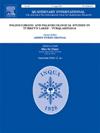Morphological characteristics of eskers in areas with soft and hard bed: Examples from Poland and Finland
IF 1.9
3区 地球科学
Q3 GEOGRAPHY, PHYSICAL
引用次数: 0
Abstract
Constraining esker characteristics is crucial for understanding subglacial processes and reconstructing past ice sheet behaviour. This study compares the morphological characteristics of eskers in areas with soft and hard beds, using examples from Poland and Finland. Eskers in both regions display similar elongation, average sinuosity, and orientation, suggesting control by similar ice-stream configurations affecting the hydraulic gradient towards the ice margin. Differences arise in the lengths, widths, heights, fragmentation, and spacing of eskers, influenced by the lithology and transmissivity of the substratum. In soft bed areas, eskers are less fragmented and show a more stable and gradual ice stream retreat, often associated with tunnel valleys and controlled by subglacial porewater pressure and groundwater flow patterns. Hard bed areas exhibit eskers influenced by bedrock topography, with more reorganization of ice flow and meltwater drainage. The study highlights the impact of substrate properties on esker distribution and morphology, emphasizing the significance of subglacial hydrology and depositional environments in esker formation.
软床和硬床地区鼠类的形态特征:以波兰和芬兰为例
限制esker特征对于理解冰下过程和重建过去的冰盖行为至关重要。本研究以波兰和芬兰为例,比较了软床和硬床地区的eskers的形态特征。这两个地区的Eskers显示出相似的延伸,平均弯曲度和方向,表明类似的冰流配置影响了朝向冰缘的水力梯度。岩石的长度、宽度、高度、破碎度和间距都存在差异,这受地层岩性和透过率的影响。在软床地区,eskers较少破碎,并且显示出更稳定和渐进的冰流退缩,通常与隧道山谷有关,并由冰下孔隙水压力和地下水流动模式控制。硬床区受基岩地形的影响,有更多的冰流和融水排水重组。研究强调了底物性质对esker分布和形态的影响,强调了冰下水文和沉积环境对esker形成的重要性。
本文章由计算机程序翻译,如有差异,请以英文原文为准。
求助全文
约1分钟内获得全文
求助全文
来源期刊

Quaternary International
地学-地球科学综合
CiteScore
5.60
自引率
4.50%
发文量
336
审稿时长
3 months
期刊介绍:
Quaternary International is the official journal of the International Union for Quaternary Research. The objectives are to publish a high quality scientific journal under the auspices of the premier Quaternary association that reflects the interdisciplinary nature of INQUA and records recent advances in Quaternary science that appeal to a wide audience.
This series will encompass all the full spectrum of the physical and natural sciences that are commonly employed in solving Quaternary problems. The policy is to publish peer refereed collected research papers from symposia, workshops and meetings sponsored by INQUA. In addition, other organizations may request publication of their collected works pertaining to the Quaternary.
 求助内容:
求助内容: 应助结果提醒方式:
应助结果提醒方式:


